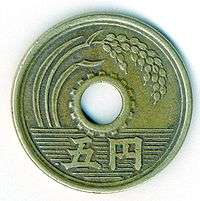Fractional yen banknotes
Fractional yen banknotes refer to 5, 10, 20, and 50 sen banknotes that were issued by the Japanese Government from 1870 to 1953. In all instances the major driving factor for the production of these notes included metal shortages to produce the equivalent coinage. None of the notes listed below retain their legal tender status.
Background
During the waning years of the Edo period, the re-opening of international trade caused a large amount of gold coins to overflow overseas. The systems that had been put into place to stop this from happening ultimately failed, causing inflation to rise and confused the public over the nation’s monetary system.[1] The Meiji government decided to move towards expanding Japan's influence in the world by strengthening military capacity to compete with Europe and the United States. In order to do this, a modern system of Japanese currency had to be established.[1] A new system was progressively adopted from 1869 to 1871 that introduced the Japanese yen, each "yen" was further fractionalized into units of "sen" and "rin". These new coins and bank notes were produced by using modern western technology of the era, and replaced the old denominations of the Edo period.[1] The fractionalized "one sen" coin equaled one-one hundredth of a yen.[lower-alpha 1]
History
During the 6th year of Emperor Taishō's reign 10 sen, 20 sen, and 50 sen notes began to be issued in response to a shortage of silver used to make the sen coins.[2][3] This situation gradually wound down as silver stabilized due to the end of World War I. The production of 20 sen notes ceased in 1919, ending that denomination as its coinage counterpart was never resumed.[lower-alpha 2] This was followed by the 10 sen note in 1921, new copper nickel coins had already debuted the year before for this denomination rather than the old silver ones.[4] The 50 sen note ceased production in 1922 becoming the last fractional notes of the Taishō era to do so. In April 1922, a new law was passed which lowered the silver content for the 50 sen coin which continued to circulate.[5]
Notes issued
5 sen note
Five sen notes were first issued in 1944 with a design featuring the statue of Kusunoki Masashige outside Tokyo Imperial Palace. The design on the back has the Government Seal of Japan also known as the "Paulownia Seals" after the Paulownia flower. While this bill was water marked to help aid against counterfeiting, no serial numbers were added. The second and last of the "5 sen" denomination were bills issued in the "A series" starting in 1948 without watermarks. The front design features the Ume (Prunus mume) flower, also known as the "Japanese plum". The words "5 Sen" are used in Arabic on the reverse for the first time, and serial numbers were added. Both of these issues were suspended in 1953 when the law abolishing the "sen" was passed.
 First series front
First series front First series back
First series back "A series" front
"A series" front "A series" back
"A series" back
10 sen note
Ten sen notes were issued from 1917 to 1921 to replace "ten sen" silver coins which had all but disappeared from circulation due to the silver shortage. After a period of absence, the notes were released again starting in 1944. The 2nd and last of these series started print in 1947, and are known as "A series" notes. Both of these series were suspended in 1953 due to the abolishment of the "sen".
20 sen note
Twenty sen notes were issued briefly from 1917 to 1919, replacing the old silver coins of the same value.
50 sen note
Fifty sen notes were issued from 1917 to 1922.
Notes
- To give an idea of this system, a United States dollar is broken down into 100 pennies.
- "20 sen" notes were officially suspended in 1921 along with "10 sen" notes.[4]
References
- "Modern Times Middle of the 19th century - First half of the 20th century". Bank of Japan (Currency museum). Retrieved February 26, 2020.
- Annual Report of the Director of the Mint (1918). United States. Bureau of the Mint. p. 234.
- Annual Report of the Director of the Mint (1919). United States. Bureau of the Mint. p. 260.
- The Numismatist. 36. American Numismatic Association. 1923. p. 65.
- Schnitzer, Julius Gabriel (1932). Leather in the British Empire: Production, Trade, and Raw Materials. U.S. Government Printing Office. p. 75.
